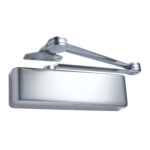This post was published in DDoor Security + Safety
.

Currently, the accessibility standards that are most commonly used in the US are the 2010 ADA Standards for Accessible Design, and the 2009 or 2017 edition of ICC A117.1 – Accessible and Usable Buildings and Facilities. These standards include the accessibility requirements for doors and hardware in Chapter 4, but information applicable to door openings is sometimes found in other chapters. For the provisions related to thresholds, we need to refer to Chapters 3 and 4 of the standards.
Changes in level at the floor surface can make it more difficult for a person using a wheelchair to maneuver through a door opening. To help mitigate these challenges, the ADA standards and ICC A117.1 contain similar requirements regarding thresholds and changes in level within an accessible route. While door openings are not required by the standards to have thresholds, if a threshold is provided, Chapter 4 limits the height to 1/2-inch, maximum. The threshold requirements apply to both manually-operated doors and automatic doors, in swinging, sliding, or folding configurations.
Existing or altered thresholds may be up to 3/4-inch in height, as long as the threshold is beveled on each side, with a maximum slope of 1:2 for the height exceeding 1/4-inch. In order to be considered an existing threshold, the installation would typically have to predate the adoption of a code or standard that limited the threshold to 1/2-inch. While this exception accounts for some existing conditions that would otherwise be difficult to remedy, compliance with the maximum height and slope mandated by the standards will make thresholds less likely to create a barrier for people passing through door openings.
In addition to the maximum allowable height, the accessibility standards require raised thresholds and changes in level at doorways to comply with Section 302 – Floor Surfaces and Section 303 – Changes in Level. These sections are found in Chapter 3 – Building Blocks, which describes core requirements that are referenced by other chapters of the standards. Section 302 requires floor surfaces to be stable, firm, and slip-resistant, and limits openings in floor surfaces to a size that does not allow a 1/2-inch diameter sphere to pass through (with some exceptions).
Although Section 302 requires walking surfaces to be slip-resistant, the standards do not currently include prescriptive requirements to establish whether thresholds and ramps used in doorways are required to be treated for slip-resistance. Most thresholds and ramps are grooved to provide some level of slip-resistance, and many manufacturers have optional finishes which create even more friction. These treatments may be helpful for particularly wide thresholds or ramps, or for those that would otherwise be smooth and could pose a hazard to building occupants.
Section 303 establishes the maximum slope for changes in level, dividing the requirements into three sections:
Vertical: A change in level of up to 1/4-inch is allowed to be vertical.
………………………….
Beveled: A change in level of 1/4-inch to 1/2-inch must be beveled with a slope not greater than 1:2.

Ramps: For changes in level greater than 1/2-inch, a ramp with a slope no greater than 1:12 must be used (with exceptions for some existing locations – see below).

In existing buildings where space is an issue, the accessibility standards allow a steeper slope for ramps. If the rise is 3 inches or less, the slope must not be steeper than 1:8. When the rise is 6 inches or less, the slope may be a maximum of 1:10. A ramp with a slope greater than 1:8 is not allowed.
The limitations on changes in level help to ensure that the small caster wheels on a wheelchair do not have difficulty navigating the floor surface. When the change in level is greater than 1/4-inch, the caster wheels may catch on the vertical rise. This can also become a tripping hazard, as the tip of a crutch or the toe of a shoe may contact the vertical portion. When the rise is greater than 1/4-inch, it is preferable for the entire height to be beveled, although the standards do allow a portion of the rise (up to 1/4-inch) to be vertical and the remainder of the rise (1/4-inch to 1/2-inch) to be beveled. Based on past interpretations, a threshold consisting of multiple vertical “steps” that are each 1/4-inch in height would not typically meet the intent of the standards.
The accessibility standards include additional requirements for ramps and sloped walkways, beyond what is addressed here with regard to changes of level within a doorway. The US Access Board publishes an online guide which explains the requirements of the 2010 ADA standards. Chapter 3 includes a section titled Floor and Ground Surfaces, which covers surface characteristics, flooring, openings, and changes in level. Chapter 4 addresses Accessible Routes, including a section on Entrances, Doors, and Gates which contains the requirements for thresholds. In addition, the International Code Council publishes a Commentary version of ICC A117.1, which includes explanatory information and graphics to help clarify the intent of the standard.
Many states have adopted accessibility standards that include modifications to the ADA standards and/or ICC A117.1. These requirements may be more stringent than what is included in the model codes and standards, so the applicable publications should be referenced for project-specific information. The Authority Having Jurisdiction (AHJ) can also be consulted regarding questions related to a particular location.
You need to login or register to bookmark/favorite this content.







Can you expand a bit on the tight existing condition allowances for ramps? I’ve had various wheelchair lift manufacturers say that they can or cannot go to the 1:8 because the new lower level platform height excludes the existing condition allowance, and others say that it does allow for it as they’re abutting adjacent existing conditions.
Thanks for sharing!
Great explanation of the code!
On those vertical thresholds (or panic thresholds) you really need to watch your door undercuts if you are going to butt the door to the vertical section.
I agree!
– Lori
Here in Illinois, we also have to follow the Illinois Accessibility Code. Makes it extra fun to make sure that the codes are the same. If not, we use the more restrictive of the codes.
Yes, the state standards and code modifications make it more challenging, but it’s job security for people who work in codes! 🙂
– Lori
I appreciate your ability to thoughtfully communicate complex ideas in ways that are easy for me to digest.
I try! 🙂
– Lori
Hi Lori, I do have a question related to this. Back a few years ago, we modified an existing opening by adding an automatic operator. The issue raised by the customer was about the door width. Even though it met ADA codes, they felt it was to narrow for the newer wide wheel chairs and motorized chairs. Just not sure if this is something that will be addressed soon. We actually changed our specs for new ADA openings to include the door to be no less than 42 inches wide.
Hi John –
The accessibility standards still require 32 inches of clear opening width, although there has been talk of needing more width for some wheelchairs. One challenge is that almost all doors in new buildings are required to comply with the accessibility standards, so I think we could potentially be looking at wider doors everywhere.
– Lori
Very well written Lori
Thanks Don! 🙂
– Lori
Great article. The vertical lip on some thresholds can be an issue. We recently had a flood door specified for a project in Florida, but when reviewing the submittal noticed that vertical lip with the gasket was 1/2″ so we could not use it.
Hi Lori,
Does anyone make an interlocking threshold that is ADA and code compliant? I’m looking for the best way to resist an under door type attack tool and an interlocking threshold seems like it may be the winner. Right now I’m forced into automatic door bottoms.
Thanks,
Mike